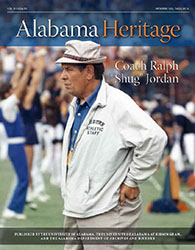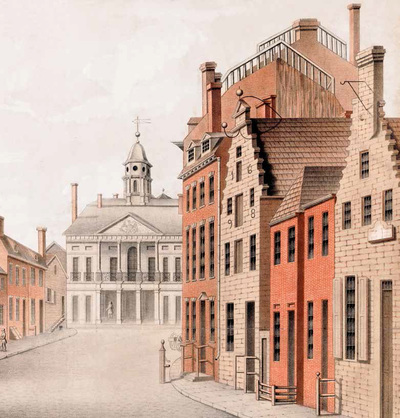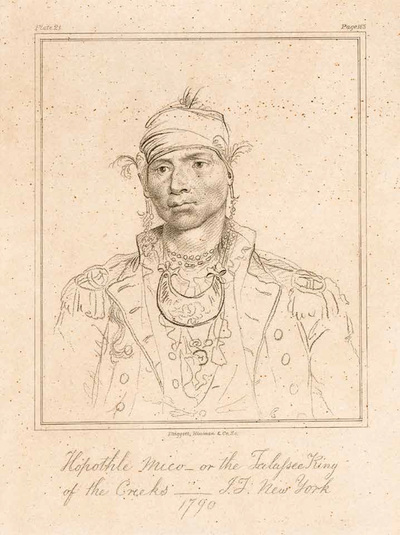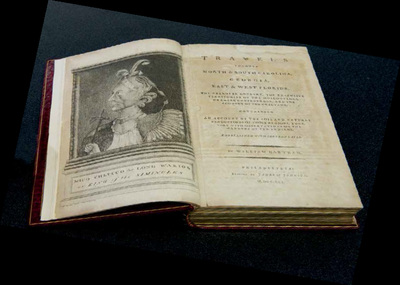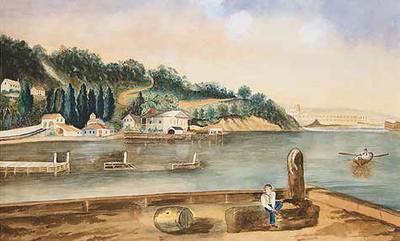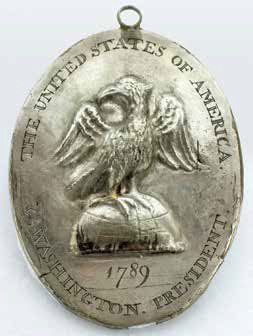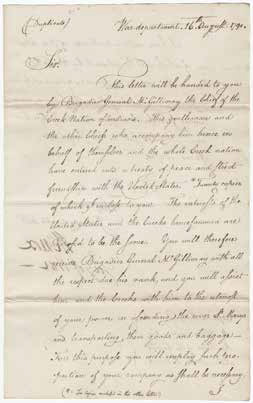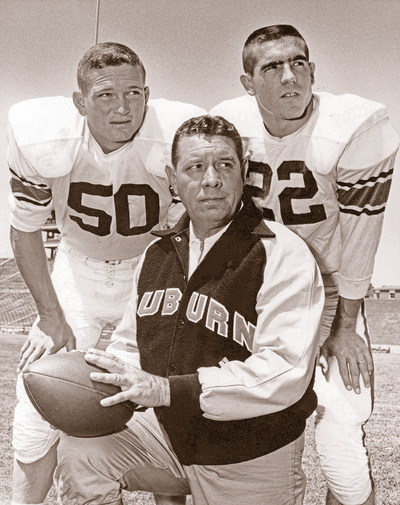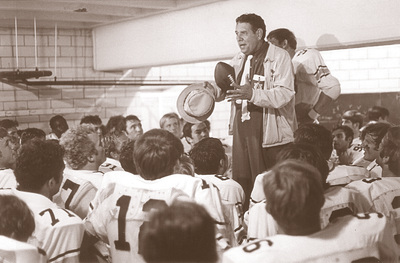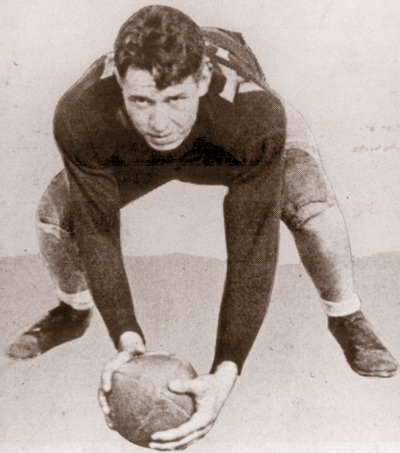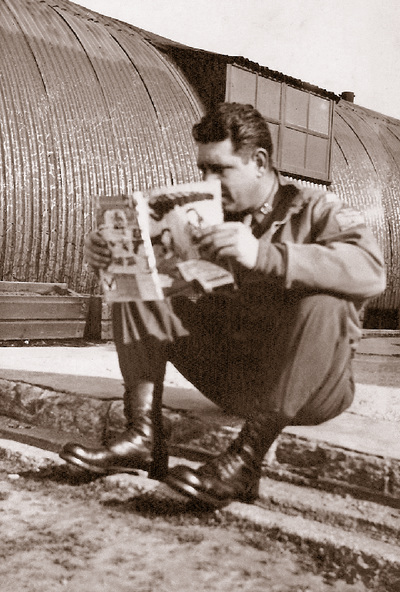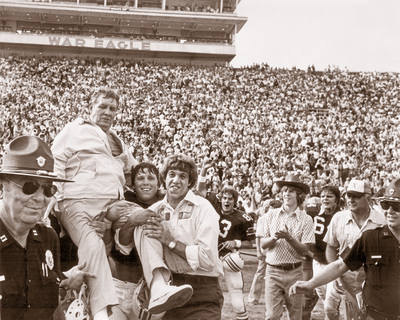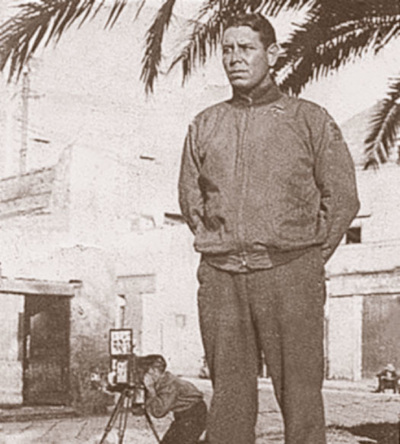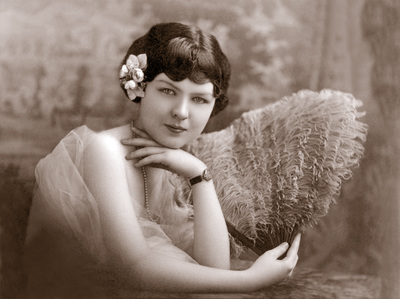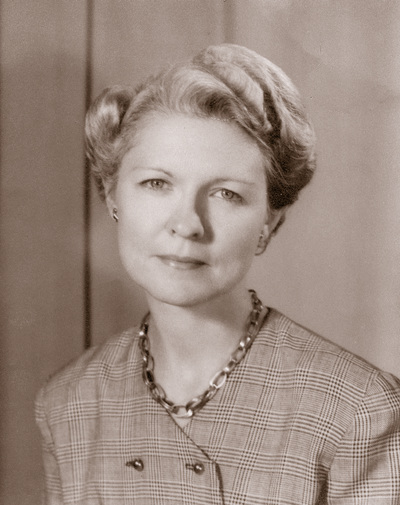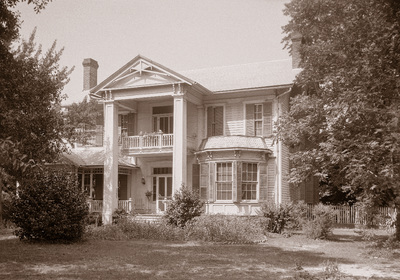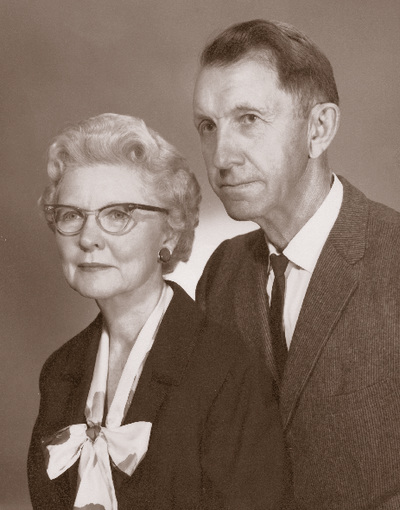|
On the cover: Auburn University head football coach Ralph “Shug” Jordan. (Auburn University Libraries Special Collections and Archives)
|
FEATURE ABSTRACTS
The Creeks Take New York
By Kathryn H. Braund
As a new nation, the United States of America eagerly embraced the actions of an independent country. The first treaty it officially entered into, which established territorial claims between the US and the Creek Nation, involved a level of pomp and circumstance worthy of the occasion. A large group of Creek emissaries traveled across the Southeast and into the Mid-Atlantic, finally descending on New York City, the young nation’s capital, for a series of social and political engagements that culminated in the treaty’s signing. Kathryn Braund describes the journey—and the significant consequences of events it contained.
About the Author
Kathryn H. Braund is Hollifield Professor of Southern History at Auburn University. She has authored or edited numerous books relating to the Creek Indians. Her first book, Deerskins and Duffels: The Creek Indian Trade with Anglo-America, 1685–1815 (University of Nebraska Press, 1993), was the first to examine the impact of the deerskin trade on all aspects of Creek society. Braund has also published scholarly articles on the southeastern Indians during the American Revolution, Creek gender and work roles, Creek women during the Red Stick war, and slavery among the Creeks. She has edited and annotated the works of three well-known eighteenth-century writers: William Bartram, James Adair, and Bernard Romans. She is also the editor of two collections of essays: Fields of Vision: Essays on the Travels of William Bartram (University of Alabama Press, 2010) and Tohopeka: Rethinking the Creek War (Pebble Hill Books, 2012). She is currently working on a book about the Creek War of 1813–1814.
Additional Information
Deerskins and Duffels: The Creek Indian Trade with Anglo-America, 1685-1815 (University of Nebraska Press, 1993) https://www.amazon.com/Deerskins-Duffels-Anglo-America-1685-1815-Southeast/dp/0803212267
Fields of Vision: Essays on the Travels of William Bartram (University of Alabama Press, 2010) https://www.amazon.com/Fields-Vision-Travels-William-Bartram/dp/0817355715
Tohopeka: Rethinking the Creek War (Pebble Hill Books, 2012) https://www.amazon.com/Tohopeka-Rethinking-Creek-War-1812/dp/0817357114
“Creeks in Alabama” (Encyclopedia of Alabama) http://www.encyclopediaofalabama.org/article/h-1088
“Treaty of New York (1790)” (Encyclopedia of Alabama) http://www.encyclopediaofalabama.org/article/h-1537
“Alexander McGillivray” (Encyclopedia of Alabama) http://www.encyclopediaofalabama.org/article/h-2313
“David Taitt” (Encyclopedia of Alabama) http://www.encyclopediaofalabama.org/article/h-1538
“Native Americans in Alabama” (Encyclopedia of Alabama) http://www.encyclopediaofalabama.org/article/s-142
Ralph “Shug” Jordan: A Quiet Heroism
By Leah Rawls Atkins
Although best known for his storied career as a football coach at Auburn University, Ralph “Shug” Jordan never forgot the influential years he spent in the US Army. Jordan’s wartime experiences spanned some of the era’s most influential events, and as a member of the team that helped plan amphibious invasions, he was directly involved in the Normandy invasion. Jordan’s role in the military helped shape his entire person, and he often drew lessons and inspiration from those days in leading the Tigers to numerous gridiron victories.
About the Author
Leah Rawls Atkins, a native of Birmingham, taught history at Auburn University, the University of Alabama at Birmingham, and Samford University, and retired as director of the Auburn University Caroline Marshall Draughon Center for the Arts & Humanities in 1995. Her husband, George,played football at Auburn for Coach Ralph “Shug” Jordan and was an assistant coach under his leadership for sixteen years. She also had many opportunities to spend time with Jordan. When she was teaching at Samford, she developed a course on World War II, where she used interviews with Jordan on his World War II experiences. Jordan was a student of Prof. George Petrie, who gave him an appreciation for history. He took a special interest in Atkins when she was in graduate school studying history. Atkins is a coauthor of Alabama: The History of a Deep South State with Wayne Flynt, William W. Rogers, and David Ward. The University of Alabama Press will be releasing a revised, updated Bicentennial Edition in late 2016.
Additional Information
Alabama: The History of a Deep South State, William Warren Rogers, Robert D. Ward, Wayne Flynt, and Leah Rawls Atkins (University of Alabama Press, 2016) https://www.amazon.com/Alabama-History-Deep-South-State/dp/0817355987
“Ralphh ‘Shug’ Jordan” (Encyclopedia of Alabama) http://www.encyclopediaofalabama.org/article/h-1502
“Auburn University” (Encyclopedia of Alabama) http://www.encyclopediaofalabama.org/article/h-1649
“Auburn University Football” (Encyclopedia of Alabama) http://www.encyclopediaofalabama.org/article/h-2032
“George Petrie” (Encyclopedia of Alabama) http://www.encyclopediaofalabama.org/article/h-2578
Auburn University Football Vault: The Story of Auburn Tigers, 1892-2007 by David Housel (Atlanta, GA: Whitman Publishing, 2007) https://www.amazon.com/Auburn-University-Football-Vault-College/dp/0794823505
On Hostile Shores by Sam Daugherty (1st Book Library, 2003) https://www.amazon.com/Hostile-Shores-Sam-Daugherty/dp/1403352461
About the Author
Leah Rawls Atkins, a native of Birmingham, taught history at Auburn University, the University of Alabama at Birmingham, and Samford University, and retired as director of the Auburn University Caroline Marshall Draughon Center for the Arts & Humanities in 1995. Her husband, George,played football at Auburn for Coach Ralph “Shug” Jordan and was an assistant coach under his leadership for sixteen years. She also had many opportunities to spend time with Jordan. When she was teaching at Samford, she developed a course on World War II, where she used interviews with Jordan on his World War II experiences. Jordan was a student of Prof. George Petrie, who gave him an appreciation for history. He took a special interest in Atkins when she was in graduate school studying history. Atkins is a coauthor of Alabama: The History of a Deep South State with Wayne Flynt, William W. Rogers, and David Ward. The University of Alabama Press will be releasing a revised, updated Bicentennial Edition in late 2016.
Additional Information
Alabama: The History of a Deep South State, William Warren Rogers, Robert D. Ward, Wayne Flynt, and Leah Rawls Atkins (University of Alabama Press, 2016) https://www.amazon.com/Alabama-History-Deep-South-State/dp/0817355987
“Ralphh ‘Shug’ Jordan” (Encyclopedia of Alabama) http://www.encyclopediaofalabama.org/article/h-1502
“Auburn University” (Encyclopedia of Alabama) http://www.encyclopediaofalabama.org/article/h-1649
“Auburn University Football” (Encyclopedia of Alabama) http://www.encyclopediaofalabama.org/article/h-2032
“George Petrie” (Encyclopedia of Alabama) http://www.encyclopediaofalabama.org/article/h-2578
Auburn University Football Vault: The Story of Auburn Tigers, 1892-2007 by David Housel (Atlanta, GA: Whitman Publishing, 2007) https://www.amazon.com/Auburn-University-Football-Vault-College/dp/0794823505
On Hostile Shores by Sam Daugherty (1st Book Library, 2003) https://www.amazon.com/Hostile-Shores-Sam-Daugherty/dp/1403352461
The Search for John Lehman
By Joey Brackner
Art historians often have a challenging task—not just identifying why a work is artistically significant, but also tracing its provenance and origins. Scholars of southern pottery have had such a task in identifying the works now attributed to John Lehman, a nineteenth-century potter whose biographical details were long hidden by lost or obscure records. Joey Brackner recounts how historians have traced Lehman, piecing together his story and gaining a better understanding of his unique pottery.
About the Author
Joey Brackner has been a folklorist with the Alabama State Council on the Arts since 1985 and since 2003 the director of the agency’s Alabama Center for Traditional Culture. He is the author of Alabama Folk Pottery (2006) published by the University of Alabama Press. Starting in 2013, he has been the host and co-producer of the Alabama Public Television series Journey Proud . Brackner is a native of Fairfield, Alabama. He received a BA in anthropology from the University of Alabama at Birmingham in 1977 and a MA in anthropology from the University of Texas at Austin in 1981. He was Humanities Scholar in Residence at the Birmingham Museum of Art prior to being hired as state folklorist in 1985.
Additional Information
The author recommends the following sources for readers who wish to learn more about southern pottery and its traditions.
Books:
Websites:
Facebook Pages:
About the Author
Joey Brackner has been a folklorist with the Alabama State Council on the Arts since 1985 and since 2003 the director of the agency’s Alabama Center for Traditional Culture. He is the author of Alabama Folk Pottery (2006) published by the University of Alabama Press. Starting in 2013, he has been the host and co-producer of the Alabama Public Television series Journey Proud . Brackner is a native of Fairfield, Alabama. He received a BA in anthropology from the University of Alabama at Birmingham in 1977 and a MA in anthropology from the University of Texas at Austin in 1981. He was Humanities Scholar in Residence at the Birmingham Museum of Art prior to being hired as state folklorist in 1985.
Additional Information
The author recommends the following sources for readers who wish to learn more about southern pottery and its traditions.
Books:
- Baldwin, Cinda. Great and Noble Jar: Traditional Stoneware of South Carolina. Athens: University of Georgia Press, 1993.
- Brackner, Joey. Alabama Folk Pottery. University of Alabama Press, 2006.
- _________. "A Heritage in Clay: The Lineage of Robert Ussery," Alabama Heritage, Tuscaloosa, AL, (Fall 2006), No. 82, pp 16-23.
- _________. "Traditional Pottery of Mobile Bay," Alabama Heritage, Tuscaloosa, Alabama, Winter 1988, No. 7, pp. 30-41.
- Burrison, John A. From Mud to Jug: The Folk Potters and Pottery of Northeast Georgia Wormsloe Foundation Publication, 2010.
- Burrison, John A. Brothers In Clay: The Story of Georgia Folk Pottery. Athens: University of Georgia Press, 1983.
- Koverman Jill Beute. 2009. Clay Connections: A Thousand-Mile Journey from South Carolina to Texas. American Material Culture and the Texas Experience: The David B Warren Symposium. Houston: Museum of Fine Arts. p 118-145.
- Koverman Jill Beute. 2005. The Ceramic Works of David Drake, aka, Dave the Potter or Dave the Slave of Edgefield, South Carolina. American Ceramic Circle Journal 13:83. http://scholarcommons.sc.edu/cgi/viewcontent.cgi?article=1021&context=mks_staffpub
- Smith, Samuel D. and Stephen T. Rogers. Tennessee Potteries, Pots, and Potters- 1790s to 1950. Tennessee Department of Environment and Conservation, Division of Archaeology, Research Series No. 18 (2011) https://tn.gov/assets/entities/environment/attachments/arch_rs18_tn_potteries_2011.pdf
- Texas Clay: Nineteenth-Century Stoneware Pottery from the Bayou Bend Collection by Joey Brackner, Amy Kurlander and Michael K. Brown, 2015.
- Zug, Charles G., III. Turners and Burners: The Folk Potters of North Carolina. Chapel Hill: The University of North Carolina Press, 1986.
Websites:
- http://www.alabamastoneware.com/
- Countryman-ForbesCollection.com
- http://randolphcountyalabamapottery.com/
- http://www.sandmountainpottery.com/
Facebook Pages:
- Collecting Alabama Pottery
- Georgia Stonewares
- Southeastern Stoneware
Viola Jefferson Goode Liddell and the Wilcox Round Table
By Tennant McWilliams
In Wilcox County, Alabama, for nearly four decades, Viola Liddell led an group of democratic intellectuals in their own “Round Table,” around which they discussed politics, the arts, writing, and southern life. Notable guests to the Round Table gatherings included authors, photographers, and even—it’s rumored—some Hollywood motion picture professionals, who visited Alabama in preparation for making the film To Kill a Mockingbird. As a writer, Liddell made her own mark on the literary world, publishing both poetry and prose, and remained a central figure of Wilcox County’s intellectual community throughout her long life.
About the Author
Tennant McWilliams, professor of history and dean, emeritus, at the University of Alabama at Birmingham, has been teaching from time to time at Samford University. His most recent book is The Chaplain’s Conflict: Good and Evil in a War Hospital (Texas A&M University Press, 2012). He lives in
Fairhope, Alabama.
Additional Information
Some of Viola Liddell’s books are available at:
http://uapress.ua.edu/product/Grass-Widow,2115.aspx
http://www.uapress.ua.edu/product/With-a-Southern-Accent,276.aspx
About the Author
Tennant McWilliams, professor of history and dean, emeritus, at the University of Alabama at Birmingham, has been teaching from time to time at Samford University. His most recent book is The Chaplain’s Conflict: Good and Evil in a War Hospital (Texas A&M University Press, 2012). He lives in
Fairhope, Alabama.
Additional Information
Some of Viola Liddell’s books are available at:
http://uapress.ua.edu/product/Grass-Widow,2115.aspx
http://www.uapress.ua.edu/product/With-a-Southern-Accent,276.aspx
Places in Peril 2016: Alabama’s Endangered Historic Landmarks
By Michael W. Panhorst
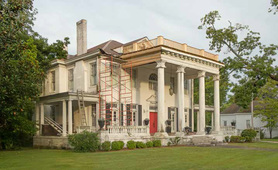 Whispering Oaks, Opelika, ca. 1900. (Robin McDonald)
Whispering Oaks, Opelika, ca. 1900. (Robin McDonald)
Each year, Alabama Heritage, the Alabama Trust for Historic Preservation, and the Alabama Historical Commission highlight significant structures in desperate need of intervention and preservation. This year’s Places in Peril list includes homes, a church, a post office, and even a cave—a natural site in dire need of preservation and support. For more information on how you might help preserve these historic parts of Alabama’s heritage, or to nominate a Place In Peril for 2017, please visit www.alabamaheritage.com/places-in-peril, www.alabamatrust.info, email [email protected], or call (205) 652-3497.
About the Author
Michael W. Panhorst, PhD, is a is a board member of the Alabama Trust, a statewide membership organization devoted to the protection and promotion of Alabama’s historic architecture, and the coordinator since 2014 of the Trust’s Places in Peril program. In June 2016 he authored a white paper, “Mount Vernon Arsenal and Searcy Hospital: The State of Alabama’s National Treasure at Risk,” at www.alabamatrust.info.
Additional Information
Places in Peril link to PDF: http://www.alabamatrust.info/pdf/al-in-peril-2016.pdf
Alabama Places in Peril Facebook page: https://www.facebook.com/Alabama-Places-in-Peril-130409373638839/
Alabama Heritage “Places in Peril” webpage: http://www.alabamaheritage.com/places-in-peril
About the Author
Michael W. Panhorst, PhD, is a is a board member of the Alabama Trust, a statewide membership organization devoted to the protection and promotion of Alabama’s historic architecture, and the coordinator since 2014 of the Trust’s Places in Peril program. In June 2016 he authored a white paper, “Mount Vernon Arsenal and Searcy Hospital: The State of Alabama’s National Treasure at Risk,” at www.alabamatrust.info.
Additional Information
Places in Peril link to PDF: http://www.alabamatrust.info/pdf/al-in-peril-2016.pdf
Alabama Places in Peril Facebook page: https://www.facebook.com/Alabama-Places-in-Peril-130409373638839/
Alabama Heritage “Places in Peril” webpage: http://www.alabamaheritage.com/places-in-peril
DEPARTMENT ABSTRACTS
 Folk artist Scott McQueen’s earliest found materials were old license plates that he cut up for their letters, as in Old Friends. (Robin McDonald)
Folk artist Scott McQueen’s earliest found materials were old license plates that he cut up for their letters, as in Old Friends. (Robin McDonald)
Alabama Makers
Scott McQueen and Fayette’s Artistic Legacy
By Curtis Clark
Scott McQueen, a chaplain whose folk art has steadily been making a name for its creator, links his artistic practice to the rich cultural heritage he encountered as a youngster in Fayette. Kentuck’s Curtis Clark explores McQueen’s artistic legacy, tracing his style through the influence of other Fayette folk artists such as Jimmy Lee Sudduth and Rev. Ben Perkins.
About the Author
Curtis Clark is the gallery shop manager at Kentuck Art Center after recently retiring as the director of the University of Alabama Press. Alfa Insurance, sponsor of the "Alabama Makers" department in Alabama Heritage, is a Montgomery-based company committed to providing its family of customers with all of its life, auto, home, farm, and business insurance needs.
Additional Information
To learn more about Scott McQueen’s project, please follow his Facebook page: https://www.facebook.com/CedarHouseCrafts
Scott McQueen and Fayette’s Artistic Legacy
By Curtis Clark
Scott McQueen, a chaplain whose folk art has steadily been making a name for its creator, links his artistic practice to the rich cultural heritage he encountered as a youngster in Fayette. Kentuck’s Curtis Clark explores McQueen’s artistic legacy, tracing his style through the influence of other Fayette folk artists such as Jimmy Lee Sudduth and Rev. Ben Perkins.
About the Author
Curtis Clark is the gallery shop manager at Kentuck Art Center after recently retiring as the director of the University of Alabama Press. Alfa Insurance, sponsor of the "Alabama Makers" department in Alabama Heritage, is a Montgomery-based company committed to providing its family of customers with all of its life, auto, home, farm, and business insurance needs.
Additional Information
To learn more about Scott McQueen’s project, please follow his Facebook page: https://www.facebook.com/CedarHouseCrafts
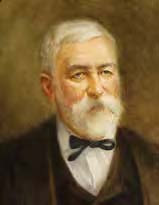 Hugh McVay by Margaret Whetstone (1938). (Alabama Department of Archives and History)
Hugh McVay by Margaret Whetstone (1938). (Alabama Department of Archives and History)
Alabama Governors
Hugh McVay (August-November 1837)
By Samuel L. Webb
Hugh McVay served as Alabama’s governor for only a few months, limiting the effect of his time in the office. Compounding this lack of influence was a lack of knowledge about several crucial issues being debated in the state at the time—a lack of knowledge some believe was perpetuated by McVey’s fellow politicians, who feared the direction his intervention might take.
About the Author
Samuel L. Webb holds a JD from the University of Alabama School of Law and a PhD in history from the University of Arkansas. This department is drawn from Alabama Governors: A Political History of the State, Second Edition, edited by Webb and Margaret E. Armbrester.
Additional Information
For more information about Hugh McVay, see http://www.encyclopediaofalabama.org/article/h-1462
For a copy of Alabama Governors: A Political History of the State, Second Edition, see https://www.amazon.com/Alabama-Governors-Political-History-State/dp/0817318437
Hugh McVay (August-November 1837)
By Samuel L. Webb
Hugh McVay served as Alabama’s governor for only a few months, limiting the effect of his time in the office. Compounding this lack of influence was a lack of knowledge about several crucial issues being debated in the state at the time—a lack of knowledge some believe was perpetuated by McVey’s fellow politicians, who feared the direction his intervention might take.
About the Author
Samuel L. Webb holds a JD from the University of Alabama School of Law and a PhD in history from the University of Arkansas. This department is drawn from Alabama Governors: A Political History of the State, Second Edition, edited by Webb and Margaret E. Armbrester.
Additional Information
For more information about Hugh McVay, see http://www.encyclopediaofalabama.org/article/h-1462
For a copy of Alabama Governors: A Political History of the State, Second Edition, see https://www.amazon.com/Alabama-Governors-Political-History-State/dp/0817318437
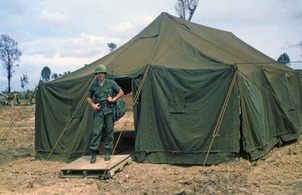 Maj. William H. Wood standing outside his tent at Camp Martin Cox (also known as Bearcat Base) in South Vietnam, December 1966. Wood, a captain in the US Air Force, was stationed in Vietnam from December 1966 to November 1967. He was promoted to major in September 1967. (Alabama Department of Archives and History)
Maj. William H. Wood standing outside his tent at Camp Martin Cox (also known as Bearcat Base) in South Vietnam, December 1966. Wood, a captain in the US Air Force, was stationed in Vietnam from December 1966 to November 1967. He was promoted to major in September 1967. (Alabama Department of Archives and History)
From the Archives
Vietnam: The Alabama Experience
By Tracey Berezansky
As Alabama marks an extended commemoration of the fiftieth anniversary of America’s involvement in the Vietnam War, the Alabama Department of Archives and History (ADAH) highlights a number of archival holdings related to Alabamians’ participation. As part of that commemoration, the ADAH would like to expand its collections documenting the Vietnam era and the lives of Alabamians in those years. Stories of soldiers and nurses; the effects on communities surrounding Fort Rucker, the Anniston Depot, and other military installations in the state; the anti-war movement, especially on university campuses; and life on the home front are all waiting to be told. Help us tell your story to future generations of Alabamians. If you are interested in donating Vietnam-related materials, please contact registrar Sherrie Hamil at [email protected] or call (334) 353-4726.
About the Author
Tracey Berezansky works for the Alabama Department of Archives and History and assists state and local agency staff members in developing retention guidelines and processes for managing official government documents. Core to this work is ensuring the long-term preservation of those official records that tell the story of Alabama.
Additional Information
“Research in Vietnam War Records” (National Archives) http://www.archives.gov/research/military/vietnam-war/
Military Records for Alabama Soldiers in Vietnam (Alabama Department of Archives and History) http://archives.alabama.gov/referenc/military
Vietnam: The Alabama Experience
By Tracey Berezansky
As Alabama marks an extended commemoration of the fiftieth anniversary of America’s involvement in the Vietnam War, the Alabama Department of Archives and History (ADAH) highlights a number of archival holdings related to Alabamians’ participation. As part of that commemoration, the ADAH would like to expand its collections documenting the Vietnam era and the lives of Alabamians in those years. Stories of soldiers and nurses; the effects on communities surrounding Fort Rucker, the Anniston Depot, and other military installations in the state; the anti-war movement, especially on university campuses; and life on the home front are all waiting to be told. Help us tell your story to future generations of Alabamians. If you are interested in donating Vietnam-related materials, please contact registrar Sherrie Hamil at [email protected] or call (334) 353-4726.
About the Author
Tracey Berezansky works for the Alabama Department of Archives and History and assists state and local agency staff members in developing retention guidelines and processes for managing official government documents. Core to this work is ensuring the long-term preservation of those official records that tell the story of Alabama.
Additional Information
“Research in Vietnam War Records” (National Archives) http://www.archives.gov/research/military/vietnam-war/
Military Records for Alabama Soldiers in Vietnam (Alabama Department of Archives and History) http://archives.alabama.gov/referenc/military
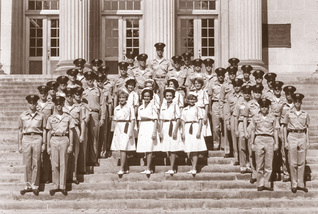 : ROTC cadets of both sexes pose on the stairs of Gorgas Library on the University of Alabama campus in 1963. (Courtesy W.S. Hoole Special Collections Library, the University of Alabama)
: ROTC cadets of both sexes pose on the stairs of Gorgas Library on the University of Alabama campus in 1963. (Courtesy W.S. Hoole Special Collections Library, the University of Alabama)
Portraits and Landscapes
The University of Alabama Reserve Officers Training Corps: 100-Year Anniversary
By Jonathan L. Goode
Although it is not officially a military school, the University of Alabama (UA) has a rich tradition of students participating in the Reserve Officer Training Corps (ROTC). In fact, the UA military cadets program predates the official founding of the United States ROTC. Jonathan Goode, a professor in the UA ROTC program, recounts the program’s history at the university and its role in military conflicts dating back to the Civil War.
About the Author
Lt. Col. (Promotable) Jonathan L. Goode serves as the Professor of Military Science for the University of Alabama's Army ROTC program.
The University of Alabama Reserve Officers Training Corps: 100-Year Anniversary
By Jonathan L. Goode
Although it is not officially a military school, the University of Alabama (UA) has a rich tradition of students participating in the Reserve Officer Training Corps (ROTC). In fact, the UA military cadets program predates the official founding of the United States ROTC. Jonathan Goode, a professor in the UA ROTC program, recounts the program’s history at the university and its role in military conflicts dating back to the Civil War.
About the Author
Lt. Col. (Promotable) Jonathan L. Goode serves as the Professor of Military Science for the University of Alabama's Army ROTC program.
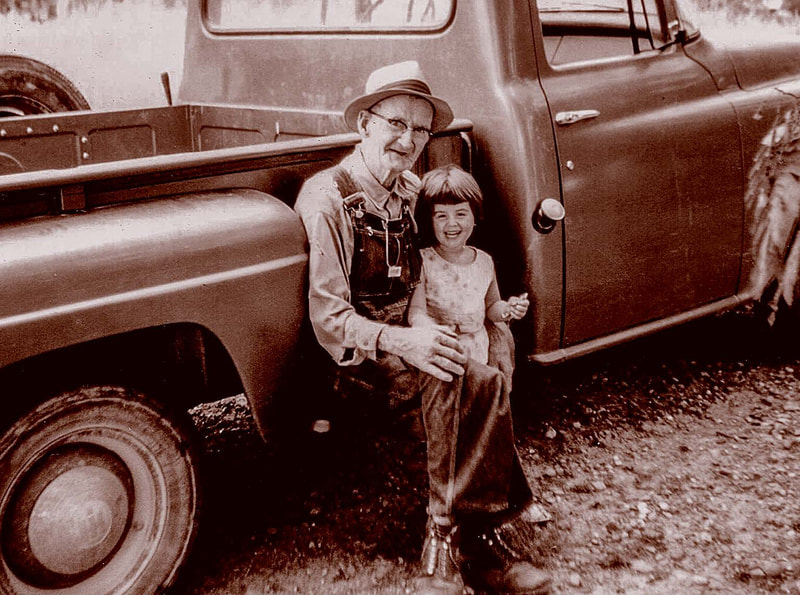 This logo will represent the Alabama Family History & Heritage Project of the state’s bicentennial. (Alabama Bicentennial Commission)
This logo will represent the Alabama Family History & Heritage Project of the state’s bicentennial. (Alabama Bicentennial Commission)
Adventures in Genealogy
Alabama Family History and Heritage Project
By Donna Cox Baker
One recurring challenge faced by many genealogical researchers is the lack of information—or access to it. As Alabama prepares to celebrate the bicentennial of its statehood, however, the Alabama Bicentennial Commission has a solution for this challenge: the creation of a digital database of genealogical and historical records, to be housed at the Alabama Department of Archives and History. This database will facilitate research and discovery, making it exponentially easier for people to learn about their own heritage.
About the Author
Donna Cox Baker has served as editor-in-chief of Alabama Heritage since 2002. She co-chairs the Statewide Initiatives Committee of the Alabama Bicentennial Commission and hosts the Golden Egg Genealogist blog (gegbound.com). If you have questions about the Alabama Family History and Heritage Project, email [email protected].
Additional Information
Golden Egg Genealogist blog: http://gegbound.com
Alabama Family History and Heritage Project
By Donna Cox Baker
One recurring challenge faced by many genealogical researchers is the lack of information—or access to it. As Alabama prepares to celebrate the bicentennial of its statehood, however, the Alabama Bicentennial Commission has a solution for this challenge: the creation of a digital database of genealogical and historical records, to be housed at the Alabama Department of Archives and History. This database will facilitate research and discovery, making it exponentially easier for people to learn about their own heritage.
About the Author
Donna Cox Baker has served as editor-in-chief of Alabama Heritage since 2002. She co-chairs the Statewide Initiatives Committee of the Alabama Bicentennial Commission and hosts the Golden Egg Genealogist blog (gegbound.com). If you have questions about the Alabama Family History and Heritage Project, email [email protected].
Additional Information
Golden Egg Genealogist blog: http://gegbound.com
Reading the Southern Past
A Tale of Two Tribes
By Stephen Goldfarb
This quarter’s installment of “Reading the Southern Past” explores the relationship between the United States and the Creek Nation through reviews of several works: William W. Winn’s The Triumph of the Ecunnau-Nuxulgee: Land speculators, George M. Troup, State Rights, and the Removal of the Creek Indians from Georgia and Alabama, 1825–38 (Mercer University Press, 2015) and Steve Inskeep’s Jacksonland: President Andrew Jackson, Cherokee Chief John Ross, and a Great American Land Grab (Penguin Books, 2015).
About the Author
Stephen Goldfarb holds a PhD in the history of science and technology. He retired from a public library in 2003.
Additional Information
The Triumph of the Ecunnau-Nuxulgee: Land Speculators, George M. Troup, State Rights, and the Removal of the Creek Indians from Georgia and Alabama, 1825-38 by William W. Winn https://www.amazon.com/Triumph-Ecunnau-Nuxulgee-Speculators-Removal-1825-1838/dp/0881465224
Jacksonland: President Andrew Jackson, Cherokee Chief John Ross, and a Great American Land Grab by Steve Inskeep https://www.amazon.com/Jacksonland-President-Jackson-Cherokee-American/dp/1594205566
A Tale of Two Tribes
By Stephen Goldfarb
This quarter’s installment of “Reading the Southern Past” explores the relationship between the United States and the Creek Nation through reviews of several works: William W. Winn’s The Triumph of the Ecunnau-Nuxulgee: Land speculators, George M. Troup, State Rights, and the Removal of the Creek Indians from Georgia and Alabama, 1825–38 (Mercer University Press, 2015) and Steve Inskeep’s Jacksonland: President Andrew Jackson, Cherokee Chief John Ross, and a Great American Land Grab (Penguin Books, 2015).
About the Author
Stephen Goldfarb holds a PhD in the history of science and technology. He retired from a public library in 2003.
Additional Information
The Triumph of the Ecunnau-Nuxulgee: Land Speculators, George M. Troup, State Rights, and the Removal of the Creek Indians from Georgia and Alabama, 1825-38 by William W. Winn https://www.amazon.com/Triumph-Ecunnau-Nuxulgee-Speculators-Removal-1825-1838/dp/0881465224
Jacksonland: President Andrew Jackson, Cherokee Chief John Ross, and a Great American Land Grab by Steve Inskeep https://www.amazon.com/Jacksonland-President-Jackson-Cherokee-American/dp/1594205566
